 |
 |
| |
|
Travel Log
Baja California Sur
Mulege Area
From San Lucas we continued down Mexico 1 a few hours drive to Mulege, a small town of just over 3000, located beside an oasis of date palms lining an estuarial river. The sight of fresh water and shady palm groves in the vast aridness of Baja almost makes you cooler, and is as welcome as the breeze blowing in from the Sea of Cortez. We both first noticed in Mulege that the tension of being in an unfamiliar culture was melting away. As we strolled the streets of this small, picturesque village, we commented to each other that we were no longer bracing against the sight of scattered garbage, poverty, and dust ( inevitable with unpaved roads). Now it all seems to be just a part of the whole, mixed in with the colors and smells and intensity of life that makes being here so special.
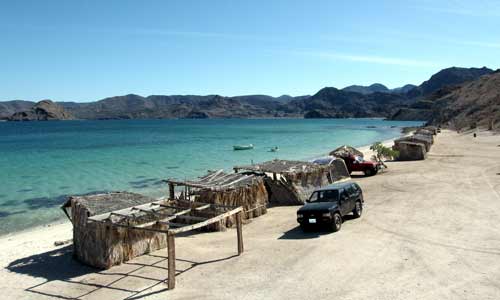 We wanted to camp on the beautiful beaches of Bahia Conception and found a spot at Playa Escondida that wasn't overrun with people celebrating Easter Week. It is easy to pass the time on the beaches here, swimming, strolling, snorkeling, exploring on the "moto", as they call our bike, or just plain relaxing. Kathleen was ready to stay awhile! But we had made plans to join Jocelyn and Dave for the Saturday pig roast and Mariachi Band at La Serenidad and so, a bit reluctantly, we moved our camp to town. We wanted to camp on the beautiful beaches of Bahia Conception and found a spot at Playa Escondida that wasn't overrun with people celebrating Easter Week. It is easy to pass the time on the beaches here, swimming, strolling, snorkeling, exploring on the "moto", as they call our bike, or just plain relaxing. Kathleen was ready to stay awhile! But we had made plans to join Jocelyn and Dave for the Saturday pig roast and Mariachi Band at La Serenidad and so, a bit reluctantly, we moved our camp to town.
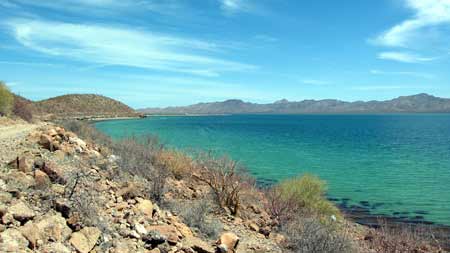
Beautiful Bahia Conception
Stove in the Mexican ranch kitchen where our lunch was cooked

View of Loreto from the Marina
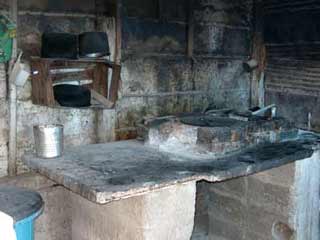 |
 |
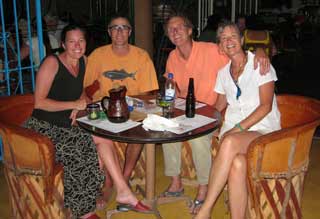 Loreto Loreto
Since our planned routes were similar and flexible and since we enjoyed them so much, we hung out with Dave and Jocelyn for much of the next two and a half weeks. In Mulege, we toured the famous ancient pictographs and petroglyphs and went to a tiny, birdlimed (a polite term which means "covered with birdshit") island far offshore where we snorkeled and dove with the sea lions, a very cool experience. And we met up again Loreto, where we hunkered down in a small, comfortable campground for a few days, sitting out Semana Santa, or Easter Week, a bigger holiday than Christmas in Mexico. All the beaches were packed cheek to jowl with families partying as only the Mexicans know how; huge quantities of beer and non-stop Ranchera music blaring from truck stereos with the doors wide open. It was a good time to hunker down in town, do laundry and other chores, and be a tourists in the beautiful, bustling town of Loreto. One day just before Easter, we thought we saw a medium-sized elephant walking down the street with a camel, to music and a police escort, but it was a hot afternoon, and we can't prove it.
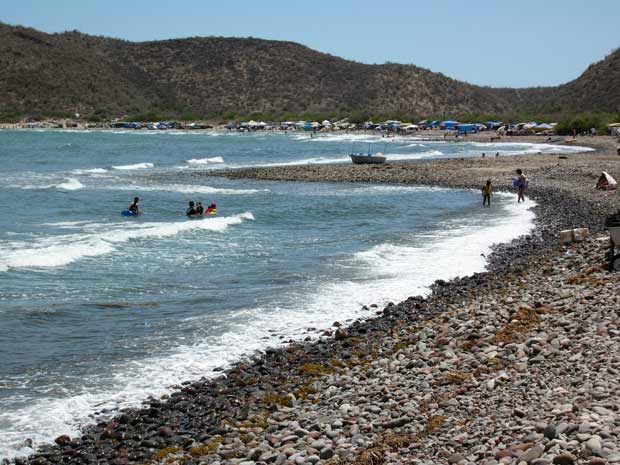 Joncalito packed with families celebrating
Semana Santa Joncalito packed with families celebrating
Semana Santa
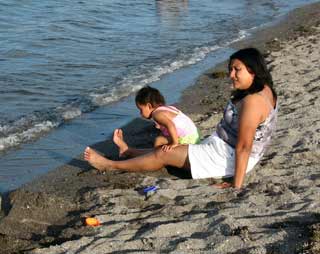 We have a new way to communicate, thanks to Dave. One morning in Lareto, he came over, excitedly telling us that he'd just signed up with Skype, a voice over internet service, and had just talked to his friend Joe in California for 30 minutes for less than a dollar, using his laptop and a small earphone/mic. We'd heard of it, but hadn't bothered to check it out yet, thinking it might be somewhat complicated to set up. Well, inside of a few minutes, Kathleen had us hooked up and we were talking with everyone we normally have a hard time reaching, as our cell service works only in a few major areas in Mexico. Using our laptop, as long as we have a good Internet connection, we can call anyone on their land line, cell, or even computer if they're on line. (And if they have SKYPE too, it's free!!) It's been a real boon to us; a million thanks, Dave! (Wonder how much we could get for our satellite phone, in unused condition?) We have a new way to communicate, thanks to Dave. One morning in Lareto, he came over, excitedly telling us that he'd just signed up with Skype, a voice over internet service, and had just talked to his friend Joe in California for 30 minutes for less than a dollar, using his laptop and a small earphone/mic. We'd heard of it, but hadn't bothered to check it out yet, thinking it might be somewhat complicated to set up. Well, inside of a few minutes, Kathleen had us hooked up and we were talking with everyone we normally have a hard time reaching, as our cell service works only in a few major areas in Mexico. Using our laptop, as long as we have a good Internet connection, we can call anyone on their land line, cell, or even computer if they're on line. (And if they have SKYPE too, it's free!!) It's been a real boon to us; a million thanks, Dave! (Wonder how much we could get for our satellite phone, in unused condition?)
Heading across to the Pacific Side
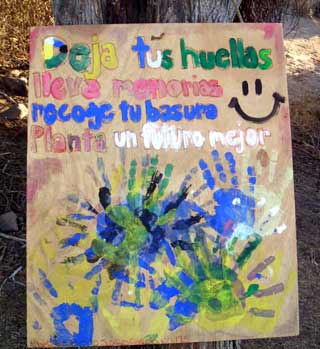 Moving south, we caught the last of Semana Santa outside San Carlos, where we camped for free on a beach crowded with friendly Mexican families. We were strolling arm in arm along the shore near sunset, a small boy stared at us unabashedly, and as we approached he asked in wonderment, "Son gringos?". (You're Gringos?) Four drunken men, who'd seen plenty of gringos before, volunteered to get us some clams, the delicious variety they call "chocolates" because of their smooth brown shells. The price we paid was close to extortion, but boy, were they delicious, breaded and fried and seasoned with lime juice. Moving south, we caught the last of Semana Santa outside San Carlos, where we camped for free on a beach crowded with friendly Mexican families. We were strolling arm in arm along the shore near sunset, a small boy stared at us unabashedly, and as we approached he asked in wonderment, "Son gringos?". (You're Gringos?) Four drunken men, who'd seen plenty of gringos before, volunteered to get us some clams, the delicious variety they call "chocolates" because of their smooth brown shells. The price we paid was close to extortion, but boy, were they delicious, breaded and fried and seasoned with lime juice.
Sign posted at an unusually clean, isolated beach: "Leave your footprints, take memories, pick up your garbage, plant a better future" (photo by Jocelyn)
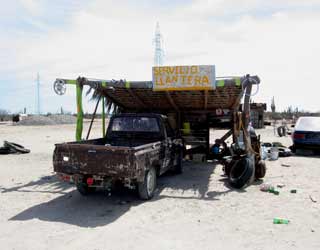 Next morning, driving back through Ciudad Constitucion, Kathleen said "Hey, there's a note that says 'RUS' taped to a sign!" We pulled over, and sure enough, it was from Dave and Jocelyn telling where they'd be in La Paz so we could join later. They'd passed us the evening before, heading out to San Carlos. We didn't see them and they couldn't turn around. How we could miss a 36-foot vehicle coming the opposite direction on a narrow road with no shoulder, honking and waving, we will never know. In light of that, then, how could we spot a small note taped to a billboard on the highway median of a busy city? Next morning, driving back through Ciudad Constitucion, Kathleen said "Hey, there's a note that says 'RUS' taped to a sign!" We pulled over, and sure enough, it was from Dave and Jocelyn telling where they'd be in La Paz so we could join later. They'd passed us the evening before, heading out to San Carlos. We didn't see them and they couldn't turn around. How we could miss a 36-foot vehicle coming the opposite direction on a narrow road with no shoulder, honking and waving, we will never know. In light of that, then, how could we spot a small note taped to a billboard on the highway median of a busy city?
Photo: tire shop in southern Baja
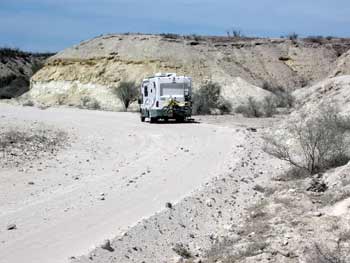 Kathleen wanted to get off Mexico 1, the one paved road that runs the length of Baja, to see some of the small towns on the Pacific Coast where tourists don't often go. She picked out the little fishing village of Puerto Chale, on Bahia Almejas (clam bay) because the dirt road there wasn't as far as other towns on the map. We turned off the paved road to suffer through 44 km of dusty washboard, so bad that vehicles had carved out alternate tracks through the desert in many places. There's a trick to washboard roads, a magic speed that allows you to ride on the tops of the troughs and keep the fillings in your teeth and the food in your fridge. For our rig, it's 38-40mph, depending on the road, but it seems a break-neck speed unless conditions are good and the road is straight, which they weren't. Halfway there we came to a broken-down car in the middle of the road, covered with blankets, a woman sitting inside to stay cool. We stopped to check on her, but she said everything was fine and help was coming, so off we continued in a trail of dust. Kathleen wanted to get off Mexico 1, the one paved road that runs the length of Baja, to see some of the small towns on the Pacific Coast where tourists don't often go. She picked out the little fishing village of Puerto Chale, on Bahia Almejas (clam bay) because the dirt road there wasn't as far as other towns on the map. We turned off the paved road to suffer through 44 km of dusty washboard, so bad that vehicles had carved out alternate tracks through the desert in many places. There's a trick to washboard roads, a magic speed that allows you to ride on the tops of the troughs and keep the fillings in your teeth and the food in your fridge. For our rig, it's 38-40mph, depending on the road, but it seems a break-neck speed unless conditions are good and the road is straight, which they weren't. Halfway there we came to a broken-down car in the middle of the road, covered with blankets, a woman sitting inside to stay cool. We stopped to check on her, but she said everything was fine and help was coming, so off we continued in a trail of dust.
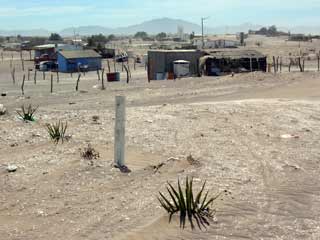 Finally arriving in Puerto Chale, we found a windswept and desolate place, not a tree or bush, hardly even cactus in sight, trash strewn by the wind, no roads, only dirt tracks leading from place to place, shacks made from cactus sticks, scraps or cinder block, widely spaced in no particular order that we could tell. The voices in our heads said ok, we've seen it, now lets get the hell out of here. But we had to go see the water first, and headed down a dirt road that turned to mud, then disappeared down a rat hole in the mangroves at the water's edge. Before we could back out again, a truck came out and boxed us in, the driver got out, introduced himself as Manuel, the brother of a fisherman who would be pleased to take us on a cruise of the bay and the three nearby islands which should not be missed (except that the wind was blowing about 25 knots, which would have been the most memorable thing about the trip). Finally arriving in Puerto Chale, we found a windswept and desolate place, not a tree or bush, hardly even cactus in sight, trash strewn by the wind, no roads, only dirt tracks leading from place to place, shacks made from cactus sticks, scraps or cinder block, widely spaced in no particular order that we could tell. The voices in our heads said ok, we've seen it, now lets get the hell out of here. But we had to go see the water first, and headed down a dirt road that turned to mud, then disappeared down a rat hole in the mangroves at the water's edge. Before we could back out again, a truck came out and boxed us in, the driver got out, introduced himself as Manuel, the brother of a fisherman who would be pleased to take us on a cruise of the bay and the three nearby islands which should not be missed (except that the wind was blowing about 25 knots, which would have been the most memorable thing about the trip). 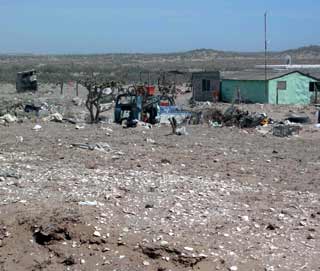 Manuel insisted on having us meet his brother anyway, so he drove away and returned 5 minutes later with his brother Jesus and a friend. Jesus, being the fisherman and boat owner, was aware of the wind factor and wasn't eager to go out either, but we all had fun talking there on the beach. After a half hour or so, we felt it was time to go, but we were hungry and asked whether there was a place in town to eat before we left. Jesus insisted we come to his house for lunch, and we somewhat reluctantly agreed. Manuel insisted on having us meet his brother anyway, so he drove away and returned 5 minutes later with his brother Jesus and a friend. Jesus, being the fisherman and boat owner, was aware of the wind factor and wasn't eager to go out either, but we all had fun talking there on the beach. After a half hour or so, we felt it was time to go, but we were hungry and asked whether there was a place in town to eat before we left. Jesus insisted we come to his house for lunch, and we somewhat reluctantly agreed.
We followed him to one of the shacks we'd passed earlier, consisting of a kitchen, a sleeping room, and an outside area sheltered from the wind by tattered blue tarps. This was where the family gathered, on an old sofa and some plastic chairs. No running water, they used a plastic tub for a sink. No electricity, a propane stove, and an outhouse. Jesus introduced us to his wife Elva Maria, his sons Eduardo, Daniel, Jesus, 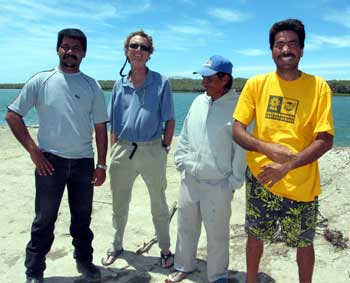 and daughters Germina and Carolina, not to mention Elva's mother, her sister and her baby. Jesus asked if we like scallops. A few minutes later, someone appeared with a bag of them, freshly shucked, and while we all sat around talking outside the kitchen, Elva made a delicious scallop ceviche, sliced raw with lime juice, onions, and cucumbers, served over crisp tortillas. If you can get scallops that fresh, try eating them raw; cooking can't improve them. Kathleen's appetite had disappeared after seeing the cooking conditions and her inner dialogue was fierce. She planned to eat just enough to be polite, but after one tostada smothered in ceviche with a touch of hot sauce she had to have another one, they were simply delicious! (There's always Pepto Bismol, she thought.) Rus had no worries and easily ate five. We were served instant coffee which we put in the cups ourselves; and Kathleen prayed silently that they had boiled the water, which was a little more than lukewarm. Jesus showed us their photos, and we brought out pictures of our kids.We talked in our halting Spanish about our families and played with their puppy. Kathleen beamed her smile at the kids, Rus pumped Jesus for information on the business of fishing, and and we gave them a postcard of our giant redwood trees (which Jesus is holding in the photo below). The women were shy and hardly spoke but the children lost their initial hesitation and we all found ways to laugh, joke, and share the bits of our lives that we knew the words for. The difficulty of communicating in our rough Spanish made the non-verbal human connection all the sweeter, and we'd just let our eyes rest a little longer on each other and trust the silences to communicate what we couldn't say. Driving off down that dusty road we realized we had met Jesus on Easter Sunday! and daughters Germina and Carolina, not to mention Elva's mother, her sister and her baby. Jesus asked if we like scallops. A few minutes later, someone appeared with a bag of them, freshly shucked, and while we all sat around talking outside the kitchen, Elva made a delicious scallop ceviche, sliced raw with lime juice, onions, and cucumbers, served over crisp tortillas. If you can get scallops that fresh, try eating them raw; cooking can't improve them. Kathleen's appetite had disappeared after seeing the cooking conditions and her inner dialogue was fierce. She planned to eat just enough to be polite, but after one tostada smothered in ceviche with a touch of hot sauce she had to have another one, they were simply delicious! (There's always Pepto Bismol, she thought.) Rus had no worries and easily ate five. We were served instant coffee which we put in the cups ourselves; and Kathleen prayed silently that they had boiled the water, which was a little more than lukewarm. Jesus showed us their photos, and we brought out pictures of our kids.We talked in our halting Spanish about our families and played with their puppy. Kathleen beamed her smile at the kids, Rus pumped Jesus for information on the business of fishing, and and we gave them a postcard of our giant redwood trees (which Jesus is holding in the photo below). The women were shy and hardly spoke but the children lost their initial hesitation and we all found ways to laugh, joke, and share the bits of our lives that we knew the words for. The difficulty of communicating in our rough Spanish made the non-verbal human connection all the sweeter, and we'd just let our eyes rest a little longer on each other and trust the silences to communicate what we couldn't say. Driving off down that dusty road we realized we had met Jesus on Easter Sunday!
 . .
Our friends in Puerto Chale
Before leaving we offered to pay for the delicious meal, not quite sure of the customs here. The grandmother refused with a certainty that left us speechless but we left some money anyway, on a stool, and hoped that it didn't offend their warmth and generosity. This family, who by our standards have so little, have quite a lot. They're tightly bonded to each other, enjoy the freedom of working for themselves, and take pride in their way of life. They showed no interest in seeing our fancy vehicle, but were very interested to see pictures of our kids, especially the ones of them posing with the fish they catch off the California coast!
We're glad we didn't (or couldn't) follow our initial response to get out of Puerto Chale as soon as possible. We'd have nothing to remember but a bad road and a shabby-looking village.
La Paz, the city of Peace
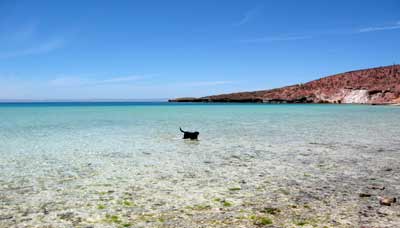
Playa Pichilingue
We arrived in La Paz just fine, and found our friends Dave and Jocelyn in a park with lovely gardens and plenty of shade, right in town. La Paz is a lot of people's favorite city in Mexico, and it's easy to see why: beautiful sandy beaches, fine old buildings, plazas, great restaurants, a wide new malecon (seafront walkway), and a bustling economy. It would have been easy to spend months there, but we're trying to get to South America, right?
 One day the four of us hired a guide, Arturo, to take us out to Isla Espiritu Santo, a huge island off Pichilingue, north of town. The island is a protected area, with limited fishing and many of its pristine beaches are off limits, though boats can anchor offshore. Arturo was a wonderful guide and an expert boatman. In six hours, he generously showed us everything he could, navigating into caves, through arches, over wrecks visible in the crystal clear water, sharing his considerable knowledge of the resident birds and other animals. When we stopped to swim with the sea lions, the anchor wedged into the rocks and wouldn't come up. After pulling and pulling, Arturo just dove in, no mask or fins, followed the rope down about 30 feet and resurfaced with the anchor (he later told us he'd been a master diving instructor with his own shop in Cabo). Further endearing himself to Kathleen's heart, Arturo One day the four of us hired a guide, Arturo, to take us out to Isla Espiritu Santo, a huge island off Pichilingue, north of town. The island is a protected area, with limited fishing and many of its pristine beaches are off limits, though boats can anchor offshore. Arturo was a wonderful guide and an expert boatman. In six hours, he generously showed us everything he could, navigating into caves, through arches, over wrecks visible in the crystal clear water, sharing his considerable knowledge of the resident birds and other animals. When we stopped to swim with the sea lions, the anchor wedged into the rocks and wouldn't come up. After pulling and pulling, Arturo just dove in, no mask or fins, followed the rope down about 30 feet and resurfaced with the anchor (he later told us he'd been a master diving instructor with his own shop in Cabo). Further endearing himself to Kathleen's heart, Arturo  consented to taking Ziggy on board, but only after K said she wouldn't go without her. It turned out having a dog aboard was a first for him. Ziggy was perfect all day! Perhaps her exemplary behavior will pave the way for future dogs to experience the wonders of Isla Espiritu Santo with their owners! It was a magical day; topped off by a pod of dolphins who came to swim around and under the boat and delight us with their antics. We felt totally exhilarated seeing so much beauty. consented to taking Ziggy on board, but only after K said she wouldn't go without her. It turned out having a dog aboard was a first for him. Ziggy was perfect all day! Perhaps her exemplary behavior will pave the way for future dogs to experience the wonders of Isla Espiritu Santo with their owners! It was a magical day; topped off by a pod of dolphins who came to swim around and under the boat and delight us with their antics. We felt totally exhilarated seeing so much beauty.
Arturo even made us lunch!....................>
Cabo San Lucas
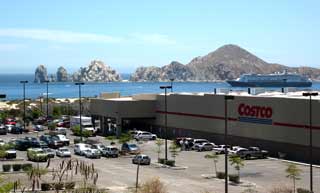 Rus didn't particularly want to visit Cabo San Lucas, but Kathleen did, after hearing about it all her life, and so we went. Jocelyn had lived there several years before, so she knew it well; in fact she and Dave had first met there, so Cabo has a special significance for them. In short, we had good guides. Rus' resistance melted in the face of the clear, warm water, fine beaches with fantastic snorkeling, beautiful resorts, and great restaurants. It's no use railing against the crazy pace of development here; better to just find something to like and like it. We snorkeled in the pristine water of Playa Santa Maria and masqueraded as guests at the beautiful old Twin Dolphins Resort, drinking Margueritas and lounging in their perfect pool high above the ocean. We also met Jocelyn's old boss Tracy, Rus didn't particularly want to visit Cabo San Lucas, but Kathleen did, after hearing about it all her life, and so we went. Jocelyn had lived there several years before, so she knew it well; in fact she and Dave had first met there, so Cabo has a special significance for them. In short, we had good guides. Rus' resistance melted in the face of the clear, warm water, fine beaches with fantastic snorkeling, beautiful resorts, and great restaurants. It's no use railing against the crazy pace of development here; better to just find something to like and like it. We snorkeled in the pristine water of Playa Santa Maria and masqueraded as guests at the beautiful old Twin Dolphins Resort, drinking Margueritas and lounging in their perfect pool high above the ocean. We also met Jocelyn's old boss Tracy,  a refugee from Ireland, who owns a big catering company with over 100 people. She took us to dinner at the best Japanese restaurant on the planet so far, Nick San. What a social scene, too; beautiful people dressed to the nines, quite a few coming over to our table to greet Tracy, a big-shot here, with those wispy Mexican cheek kisses. Tracy ordered for us, and soon a steady flow of the most exquisite food we've ever seen started arriving at our table, and disappearing into our mouths. An authentic Cabo San Lucas experience! a refugee from Ireland, who owns a big catering company with over 100 people. She took us to dinner at the best Japanese restaurant on the planet so far, Nick San. What a social scene, too; beautiful people dressed to the nines, quite a few coming over to our table to greet Tracy, a big-shot here, with those wispy Mexican cheek kisses. Tracy ordered for us, and soon a steady flow of the most exquisite food we've ever seen started arriving at our table, and disappearing into our mouths. An authentic Cabo San Lucas experience!
At right:Rus testing the water at Twin Dolphins
Below: a visit from a handsome local who liked tomato pieces enough to come close
 It was finally time, though sad as well, to say good-bye to our friends Dave and Jocelyn and move on. We wanted to see Cabo Pulmo, around the tip of Baja on the Sea of Cortez, famous for its coral reef and fine diving and snorkeling. Cabo Pulmo was beautiful indeed, but the wind had churned up the water and visibility was limited. Still, it was a treat to swim around a real coral reef, rare in Baja, and visit with the local resident fish. It's amazing how fertile these waters are; as soon as you put your head under water, you enter another world teeming with life of the most brilliant colors and beautiful shapes. Ziggy swam along side us the whole time we snorkeled, was rather in the way at times, but we couldn't get her to stay on shore, never being one to miss out on a swim. It was finally time, though sad as well, to say good-bye to our friends Dave and Jocelyn and move on. We wanted to see Cabo Pulmo, around the tip of Baja on the Sea of Cortez, famous for its coral reef and fine diving and snorkeling. Cabo Pulmo was beautiful indeed, but the wind had churned up the water and visibility was limited. Still, it was a treat to swim around a real coral reef, rare in Baja, and visit with the local resident fish. It's amazing how fertile these waters are; as soon as you put your head under water, you enter another world teeming with life of the most brilliant colors and beautiful shapes. Ziggy swam along side us the whole time we snorkeled, was rather in the way at times, but we couldn't get her to stay on shore, never being one to miss out on a swim.

Cabo Pulmo
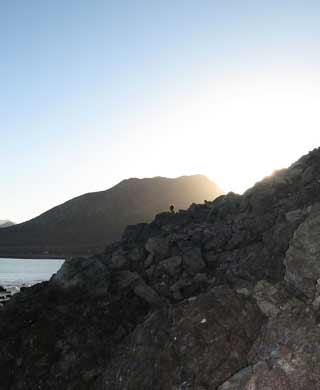 The drive back to La Paz was especially scenic, or maybe our love for Baja after getting to know her so well and the fact that we were leaving made it seem more lovely. We were treated to more colorful roadside shrines, the small mining town of El Triunfo enchanted us, and mysterious trees began to appear. Big trees with smooth, peeling bark that glows strongly golden in the afternoon sun. We never found out their name and have never seen them again, Baja is a land of intriguing plants. But there was no more time for photo stops, we were heading for the ferry to take us to the Mainland. We decided to take the short six-hour transit to Topolobampo, as the ferry to Mazatlan was 18 hours, with no sleeping facilities. Later we found we could have asked for a place on the top vehicle deck and slept in our rig. But the ferry was comfortable, with two lounges, a restaurant and a bar, and showed non-stop Hollywood action/adventure movies dubbed in Spanish. Arriving in Topolobampo at 9:00 p.m., we drove around to the truck area in the ferry terminal and parked there for the night, as we've done at other ferry crossings, before setting out for Mazatlan early next morning. The drive back to La Paz was especially scenic, or maybe our love for Baja after getting to know her so well and the fact that we were leaving made it seem more lovely. We were treated to more colorful roadside shrines, the small mining town of El Triunfo enchanted us, and mysterious trees began to appear. Big trees with smooth, peeling bark that glows strongly golden in the afternoon sun. We never found out their name and have never seen them again, Baja is a land of intriguing plants. But there was no more time for photo stops, we were heading for the ferry to take us to the Mainland. We decided to take the short six-hour transit to Topolobampo, as the ferry to Mazatlan was 18 hours, with no sleeping facilities. Later we found we could have asked for a place on the top vehicle deck and slept in our rig. But the ferry was comfortable, with two lounges, a restaurant and a bar, and showed non-stop Hollywood action/adventure movies dubbed in Spanish. Arriving in Topolobampo at 9:00 p.m., we drove around to the truck area in the ferry terminal and parked there for the night, as we've done at other ferry crossings, before setting out for Mazatlan early next morning.
So many of the roadside Shrines of Baja California are enchanting
 |
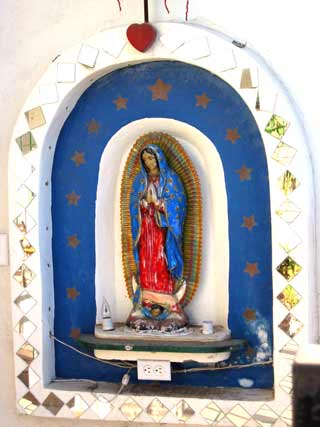 |
 |
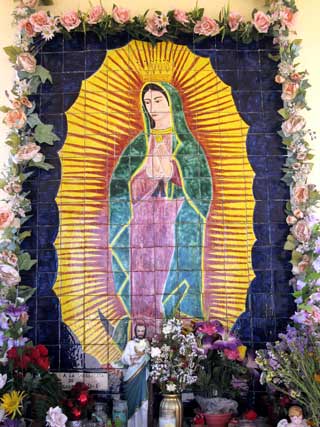 |
 |
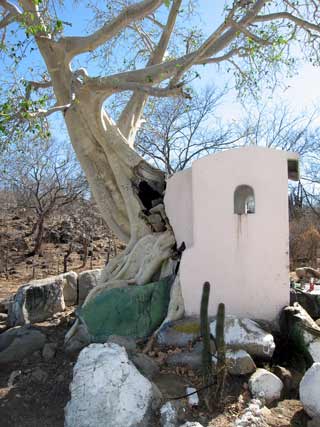 |
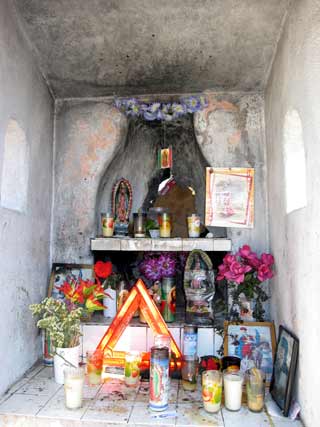
Inside the Tree Shrine
shown above
First Impressions
We've been in Mexico just a month, but we thought it would be interesting to note some of our first impressions, if only so that we could laugh at ourselves re-reading them a few months later. We've decided to write down, for your amusement and ours, our most glaring impressions of some of the things we've encountered that are so different than at home.
|
ROADS: Considering that Baja's Mexico 1 wasn't even paved the first time Rus traveled it, this small two lane highway is a tremendous improvement.......and paved it is, unlike many roads in Baja. Still, Mex 1 is pretty tough to drive. Unmarked topes (speed reducing bumps) exist in surprising places, often without warning. And even worse are the narrowness and complete lack of shoulders, combined heavy use by every kind and condition of vehicle. When a big bus or truck comes barreling down the opposite lane it feels like you may have an inch or two to spare between you. If you go off the road, you'll be over on your side or worse, because it drops abruptly on either side of the white line. Some old or heavily loaded vehicles inch along with a string of others behind them. The highway climbs and twists through mountains and hangs at the edge of steep ocean cliffs where daring drivers pass with seemingly little visibility. So far the mainland roads have been much better, but we don't expect this to continue. What offsets the quality of the roads is the skill and attentiveness of the drivers here. As in most countries with poorer roads, drivers in Mexico are competent, courteous, communicative, and alert. The ones who aren't are slowly "selected" out, but unfortunately they sometimes select out good drivers when they go. There are roadside memorial crosses everywhere, and more elaborate roadside shrines as well. People don't mess around; they really put those shrines to use, stopping to light a candle, crossing themselves, and driving on. It's as essential as gasoline. By contrast, the U.S. has the best roads and the worst drivers, because there are usually no consequences for bad driving, and the same bad habits can be repeated time and time again. We have the feeling, though, that as we continue south we'll grow nostalgic for Mexico's fine roads.
|
|
Food:Rus is gaining weight, and now has a little handle on his waist. Sometimes Kathleen teases him by grabbing onto it when they're on the motorcycle. It's because he eats too much and has no self-control. But Mexican food is so good, he doesn't even care if it kills him. (Oh, yeah. He forgot to mention the beer!) On the coast, we've been concentrating on the fantastic seafood, and have only scratched the surface. There are so many kinds of fish and shellfish, it would take months to become familiar with them all, and we're willing to give it a try. Inland, the food gets much more complex and regional, we've heard, especially where there's a strong Indian influence. More on this as we eat our way through the country.
 We are loving the fruits and vegetables. We bought a small hand juicer which takes only minutes to make fresh orange juice for our breakfast. The small Mexican limes are also a staple item, and we squeeze them on just about everything we eat. Mangos and Papayas are in our regular diet, too. And we couldn't survive without fresh cilantro every day; it's a major vegetable. Kathleen makes a great fresh salsa with tomatoes, onions, garlic, cilantro, jalapenos and lime juice that is pretty much a staple item as well, along with avocados, either sliced or made into guacamole. As with seafood, the variety of fruits and vegetables is nearly endless, and we're curious to try some of the stuff we don't even recognize, much less know how to prepare. We are loving the fruits and vegetables. We bought a small hand juicer which takes only minutes to make fresh orange juice for our breakfast. The small Mexican limes are also a staple item, and we squeeze them on just about everything we eat. Mangos and Papayas are in our regular diet, too. And we couldn't survive without fresh cilantro every day; it's a major vegetable. Kathleen makes a great fresh salsa with tomatoes, onions, garlic, cilantro, jalapenos and lime juice that is pretty much a staple item as well, along with avocados, either sliced or made into guacamole. As with seafood, the variety of fruits and vegetables is nearly endless, and we're curious to try some of the stuff we don't even recognize, much less know how to prepare.
Mexico is a tough place for vegetarians, so Kathleen has decided to eat some meat while we're traveling to make her life a little easier. A lot of Mexican comida is greasier than she likes, so she wants to eat at home more than Rus does. Her current favorite staple in inland restaurants is tortilla (or Aztec) soup which is served with avocado and other fresh toppings and tastes hearty and nutritious. She's noticed that the salsa keeps getting hotter the further South we go. Buying meat at the markets leaves no doubt about its source, as sometimes the heads, tails and feet are on display and for sale right next to the rest of the animal. For those who "love the meat but can't stand the killing", the butcher stalls may be best avoided. But it's very fresh, even if some of the cuts are unrecognizable. Beef is often cut into strips, chopped into small pieces, or even shredded. A steak as we know it is uncommon, usually a thin slice of some indiscriminate cut, thrown on a charcoal grill and cooked well-done. And Rus thinks it's pretty good!
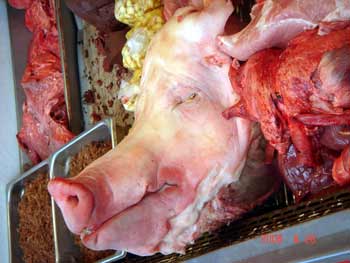
As for drinks, beer is a big deal here, and a refreshing change from the complexity of the rest of Mexican cuisine. If you can't find your brand, that's ok; it's all about the same, like the popular American pilsners. Also as in the U.S., advertising is fierce and ubiquitous, since advertising is the only thing that differentiates the products. If you like the major American brands, you'll like Mexican beer, and we've grown to like it, too. Tequila is another matter, as complicated as single malt scotches, and sometimes as expensive. We don't know anything about this yet, but we're willing to learn. Mexico also has many other nonalcoholic drinks, such as horchada, made with rice flour; atole, a thick drink made with fine corn meal; and wonderful fruit liquados, smoothies that can be made with milk or yogurt and just about anything else. Also popular, of course, is an imported drink called Coca Cola.
|
POLICE: Mexico's municipal traffic and public safety police have a notorious reputation for taking bribes, or "mordidas". We had no problem in Baja California, but as soon as we hit Mazatlan, Rus was pulled over twice on our motorcycle. Once for not having a helmet; two days later for running a red light. The officers were both very polite, explaining the infraction, asking for his license, telling him what the fine would be if he wrote a ticket to pay at the station, and how he could pay a reduced fine directly to the officer and avoid the extra expense. The "reduced fine" was open to negotiation at that point, but both times it ended up at 100 peos, or about 10 dollars. That seemed to be the magic number in Mazatlan, but don't take our word for it; make your own best deal, since mordidas vary widely. Once the fines were handed over, both officers shook his hand, warned him to be more careful, wished him a good day and drove off.
Usually, the police don't pull you over for nothing; Rus was in the wrong both times, and was actually thankful for the reminders to be more safety conscious and observant. It only cost 20 bucks, and might have saved our butts already; who cares where it went? In case we run into a really tough cop, though, we've taken some precautions: we both carry high quality laminated copies of our drivers licenses, not our real ones. If we get into a standoff situation and can't get our licenses back, no big deal. Sometimes cops will also remove your license plate if you're improperly parked, to extort a hefty fine, so we've taken our front plate (California has two) and fastened it to our rear with industrial adhesive, and put a clear plastic cover over it. The real rear plate with the registration stickers is safely inside our rig. So if a cop does succeed in prying it off he can have it. Mexicans have told us to avoid driving in Mexico City at all costs. If the traffic doesn't get you, the traffic cops will, and the mordidas are extravagant. We've heard even the best bypass route is being patrolled now, so we guess we'll even bypass that. With over 25 million people there, we won't be missed.
|
GARBAGE: Mexico has made visible strides to improve its garbage problem. There are garbage cans available in most places, even in the smaller towns and along the highways, and municipal dumps are well-used if not well-maintained. There are signs everywhere asking people not to throw trash on the highways, beaches, parks and other public places. Plastic bags and beverage bottles are strewn everywhere, though, an enduring symbol of Mexico's entry into the global economy. We remember when everyone brought their string bags to the market, but if you could find one for sale now, they'd bag it in plastic for you, like everything else. The sight of garbage is hard to get used, as is the smell of burning plastic or, worse yet, tires. But that seems to be a part of Mexico in many places, at least for the time being.

Burning tires in the dump
|
CONSTRUCTION: Why are there so many buildings, large and small, in various stages of incompletion in Mexico? It could be anything from a goat shed to a port development project, it doesn't seem to matter. We don't care so much about the goat sheds, but it's heartbreaking to see a large, expensive project abandoned half-finished or in ruins. Also, there's some kind of problem with concrete in Mexico. Maybe it's the ratio of cement to aggregates, maybe there's salt in the water or sand, maybe it's not cured correctly, we don't know. But too often the stuff just starts crumbling after a few years, the exposed re-bar rusting. We've heard different explanations for these problems, such as public projects conceived by politicians just to win votes with no concern for the project's viability, or contractors skimping on cement to save money, or that property taxes don't accrue on a building until it's completed and so it never is, even if it's being used. A trusted source tells us this isn't true, the building is assessed and taxes are paid on whatever they've built, and reassessed later if more is added. Many times homeowners have to build or remodel on a cash basis, if no bank loans are available, so when the cash runs out, so does the construction, until later if and when more cash is available.
|
| |
POLITICS: This is an election year, and at this writing, the national presidential elections are only 6 weeks away. The two leading candidates, Felipe Calderon, from the right wing PAN party, and Andres Manuel Lopez Obrador, from the left wing PRD, are running neck-to-neck. Mexico is saturated with political advertising right now, most of it from the right, and Calderon has even hired the American political consultant and Fox News commentator Dick Morris to guide his campaign in the final stretch. Morris is very savvy, running an American-style campaign on a proven formula: appeal to fear and ignorance. But right now, all Mexico is up in arms about the militarization of the border by the National Guard and other immigration issues, and anger over more U.S. restrictions may override fear mongering by the Right. If Lopez Obrador wins, it will result in a close alliance with the other Leftist governments of Venezuela, Bolivia and Chile, and a dramatic decrease in U.S. influence in Latin America. This is going to be an interesting trip!
|
| |
|
|
|
 |
|
 |

